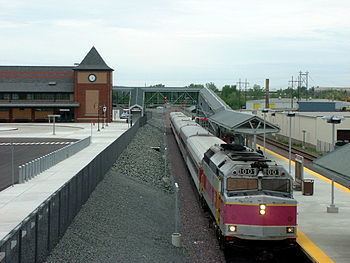Status Operational Locale Massachusetts | Operator(s) Keolis North America Stations 9 | |
 | ||
Daily ridership 11,965 (weekday average, 2014) Opened 1835 (Boston & Lowell Railroad) | ||
Mbta railroad double lowell line trains at west medford rr f40ph
The Lowell Line is a railroad line of the MBTA Commuter Rail system, running north from Boston to Lowell, Massachusetts. Originally built as the Boston & Lowell Railroad and later operated as part of the Boston & Maine Railroad's Southern Division, the line was one of the first railroads in North America and the first major one in Massachusetts.
Contents
- Mbta railroad double lowell line trains at west medford rr f40ph
- Mbta mbcr automated station calls lowell line
- History
- Expansions
- Track speeds
- Other services
- Station listing
- References
All stations are wheelchair accessible except for West Medford, Winchester Center, and Mishawum.
Mbta mbcr automated station calls lowell line
History
The Boston & Lowell Railroad started freight operations in 1835, with traffic from the Lowell mills to the Boston port. Demand for the express passenger service exceeded expectations, and in 1842 local service was added as well. The line north of Lowell was first owned by the Boston, Concord & Montreal Railroad, which was chartered in 1844. Trackage was completed as far as Wells River, Vermont, in 1853. The Boston & Maine Railroad (B&M) acquired the railroad in 1895. The line served as the route for Boston to Montreal service during the Golden Age of Rail (roughly 1880 to 1930). The Ambassador, the train from Boston's North Station to Montreal, ran through Concord, New Hampshire, along this line until 1966. This line, along with the New Englander, via Concord, White River Junction, Montpelier, ran through the northwestern section of Vermont prior to entering Quebec, Canada. The Alouette and Red Wing trains travelled to Montreal via Concord, Wells River and Newport in northeastern Vermont prior to entering Quebec. (The route via Wells River, St. Johnsbury and Newport was the more direct route of the two itineraries.) For this itinerary the Montreal route was marketed as an Air-line railroad.
B&M passenger service to Boston on the line was shortened from Nashua, New Hampshire to Lowell in 1967.
In 1973 the MBTA bought the Lowell line, along with the Haverhill and all other local Greater Boston passenger lines. Along with the sale, the B&M contracted to run the passenger service on the Lowell line for the MBTA. After bankruptcy, The B&M continued to run and fulfill its Commuter Rail contract under the protection of the United States Bankruptcy Court, in the hopes that a reorganization could make it profitable again. It emerged from the court's protection when newly formed Guilford Transportation Industries (GTI) purchased it in 1983.
For approximately thirteen months in 1980-81, daily passenger service was provided to Concord. Two round-trips were operated on each weekday and one on weekend days. Originally, there were intermediate stops in Manchester and Nashua. A stop in Merrimack was added later. Service was discontinued when federal funding was withdrawn.
In 2001, the Amtrak Downeaster began operating over the line south of Wilmington.
Expansions
As of 2011, there is a current debate over whether or not to expand the Lowell line to Nashua, New Hampshire and include stations in North Chelmsford and Tyngsborough en route, for the sake of commuters in those towns.
In January 2011, a bill was introduced into the New Hampshire legislature to end the proposed extension and give up a potential $4.1 million grant into its planning.
The MBTA is currently building the Green Line Extension through Somerville and part of Medford. One branch of the Extension will follow the right of way of the Lowell Line into Medford. Several stations once existed along that section of the line, but none are in operation any longer.
Track speeds
North of Wilmington, the line is authorized for a maximum of 60 miles per hour (97 km/h). South of Wilmington, the line has an unusual asymmetrical speed limit. The northbound track supports up to 70 miles per hour (110 km/h) where curvature allows, while the southbound track has a maximum of 60 miles per hour (97 km/h). Additional speed restrictions are in place at Wilmington, through the grade crossings in West Medford, and in the North Station terminal area.
Other services
Amtrak's Downeaster service to Maine, along with some Haverhill Line express trains, run on the Lowell Line from North Station to Wilmington, then follow the Wildcat Branch to the Haverhill Line. This routing is used to avoid the inner Haverhill Line, which has a number of single-track sections.
The line is the designated freight clearance route into Boston from the north; all stations with high-level platforms must either have mini-high platforms or a freight passing track. Pan Am Railways runs freight on the line, including local freights based out of Lawrence Yard and DOBO (a Dover to Boston through freight).
Station listing
Operating stations are shaded in purple; stations closed during the MBTA era are also listed.
